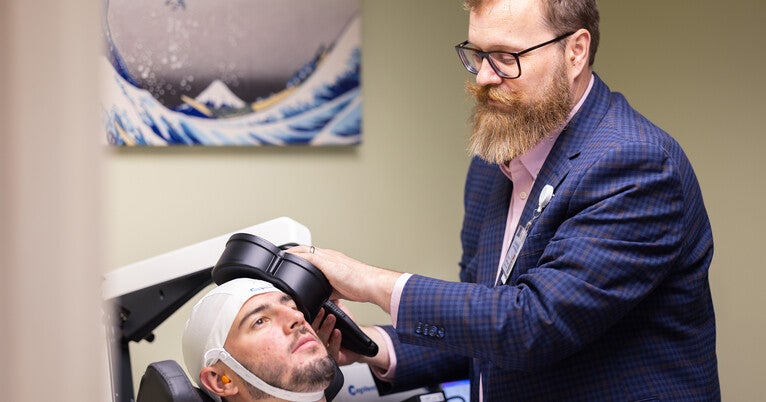The study is funded by Yale’s Department of Psychiatry and the Olin Neuropsychiatry Research Center at Hartford Hospital.
In an interview, Steele discussed the pressing need for new addiction treatments and the hope that TMS could hold for so many people.
The interview has been edited for length and clarity.
How does TMS work in the brain of someone who has an addiction?
Vaughn Steele: I hesitate to answer because we don’t exactly know what it does. But we do know that TMS uses electromagnetic pulses that generate an electric current in the brain, which then stimulates a person’s brain cells. With repeated stimulations, there’s some evidence that suggests it can change circuits in the brain or network connectivity in the brain, including addiction pathways.
I like the analogy of a gas pedal and a brake. The gas pedal fuels your craving to use drugs, and your brake — or your brain’s more disciplined, executive control functions — stop you from using drugs. These things are not balanced in people who are struggling with addiction. Sometimes people have too much craving and not enough brake or not quite enough brake. Then you can get out of control. The TMS styles that we’re using are trying to modulate one or both systems. The hope is that with TMS, we can modulate these circuits and change the behavior.
How did the idea for this summer project come about?
Steele: The general thrust of my research program is using TMS, or some sort of neuromodulation, to affect change in the brain in clinical populations. My primary focus is substance use disorders. I’ve been doing smaller TMS projects for about a decade, all leading up to the intervention this summer.
At Yale, I’ve done primarily single sessions of TMS as proof of concept to show that TMS, if put in the right place for the right sequence, can modify brain function, and behavior, in people with substance use disorders. The next step has always been trying to develop an intervention which would involve multiple sessions to try to change substance abuse behavior.
Why are new interventions and treatments such as TMS so critical now?
Steele: The treatments we have for alcohol and opiate addiction are too often insufficient to treat the underlying causes. The opioid overdose crisis we’re currently facing tells us that whatever we’re doing is not good enough. We need something else.
Opioid use disorder and alcohol use disorder are both immense public health issues, and they’re both terrible in different ways. Alcohol is a slower killer. You have more chronic issues than with opiates, where you can OD during a single use. In both cases, there are people suffering from these disorders who’ve tried multiple treatments, and they just haven’t worked.
What type of patients is TMS potentially targeting?
Steele: There’s a segment of the general population that gets addicted, and there’s a segment of that segment that is treatment resistant. A segment of that segment might respond to TMS. The goal isn’t to be able to cure addiction for everybody. But there’s a certain group of people that TMS could help. Honestly, addiction ruins your life. It takes over. If we can help give anybody their life back so that they’re not consumed with going to use their substance of choice, that would be a huge win. TMS is a tool that’s safe. It has very few side effects. It could potentially help a lot of people.
